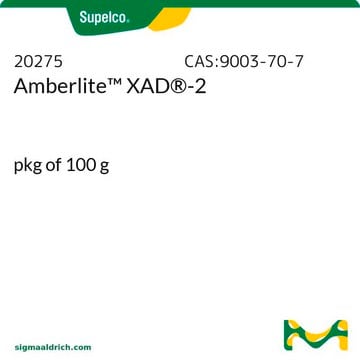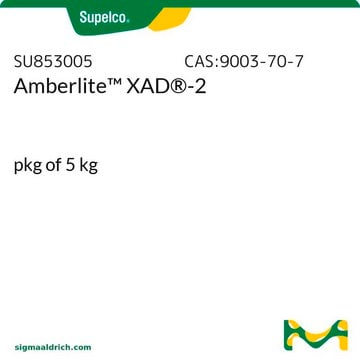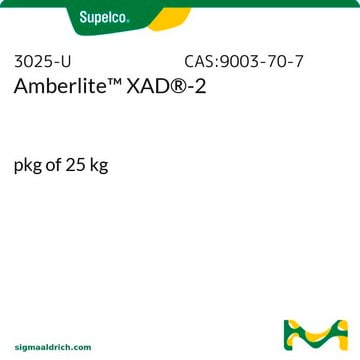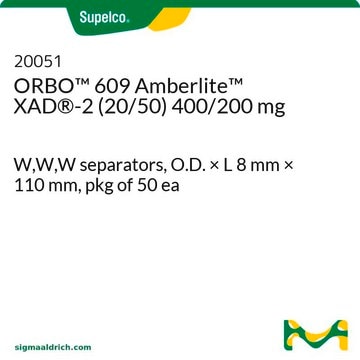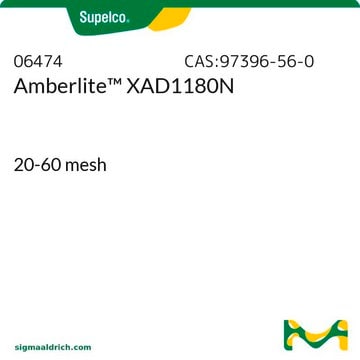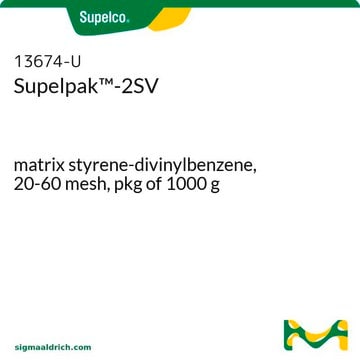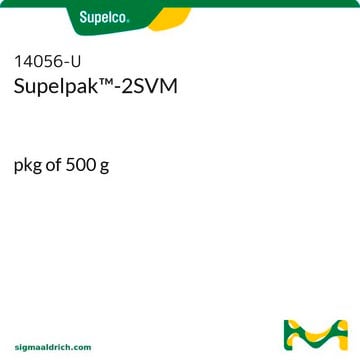If this product has an expiration or retest date, it will be shown on the Certificate of Analysis (COA, CofA). If there is no retest or expiration date listed on the product's COA, we do not have suitable stability data to determine a shelf life. For these products, the only date on the COA will be the release date; a retest, expiration, or use-by-date will not be displayed.
For all products, we recommend handling per defined conditions as printed in our product literature and website product descriptions. We recommend that products should be routinely inspected by customers to ensure they perform as expected.
For products without retest or expiration dates, our standard warranty of 1 year from the date of shipment is applicable.
For more information, please refer to the Product Dating Information document: https://www.sigmaaldrich.com/deepweb/assets/sigmaaldrich/marketing/global/documents/449/386/product-dating-information-mk.pdf
10357
Amberlite™ XAD®-2
pkg of 500 g
Seleccione un Tamaño
About This Item
Productos recomendados
Agency
suitable for ASTM® D4861
suitable for EPA Method 10A, Method 23 and OTM-45
Formulario
beads (small)
envase
pkg of 500 g
técnicas
HPLC: suitable
LPLC: suitable
superficie
~300 m2/g
Matriz
styrene-divinylbenzene (macroreticular)
grupo activo de la matriz
polymer
tamaño de partícula
20-60 mesh
tamaño de poro
~0.65 mL/g pore volume
90 Å mean pore size
densidad
1.02 g/mL at 25 °C (true wet)(lit.)
1.08 g/mL at 25 °C (skeletal)(lit.)
técnica de separación
reversed phase
temp. de almacenamiento
2-8°C
cadena SMILES
N([C@@H](CCC(=O)OC(C)(C)C)C=O)C(=O)OCC1c2c(cccc2)c3c1cccc3
InChI
1S/C24H27NO5/c1-24(2,3)30-22(27)13-12-16(14-26)25-23(28)29-15-21-19-10-6-4-8-17(19)18-9-5-7-11-20(18)21/h4-11,14,16,21H,12-13,15H2,1-3H3,(H,25,28)/t16-/m0/s1
Clave InChI
BCIPGSZQUDLGSY-INIZCTEOSA-N
¿Está buscando productos similares? Visita Guía de comparación de productos
Categorías relacionadas
Descripción general
Especificaciones:
Aplicación
Información legal
Producto relacionado
Código de clase de almacenamiento
11 - Combustible Solids
Clase de riesgo para el agua (WGK)
WGK 3
Punto de inflamabilidad (°F)
Not applicable
Punto de inflamabilidad (°C)
Not applicable
Equipo de protección personal
Eyeshields, Gloves, type N95 (US)
Elija entre una de las versiones más recientes:
¿Ya tiene este producto?
Encuentre la documentación para los productos que ha comprado recientemente en la Biblioteca de documentos.
Los clientes también vieron
Contenido relacionado
La cromatografía de líquidos a baja presión (LPLC) funciona a bajas presiones, utilizando una bomba para impulsar la fase móvil hacia la columna.
Low pressure liquid chromatography (LPLC) operates at low pressures, using a pump to drive the mobile phase onto the column.
Las PFAS o «productos químicos eternos», persisten en el medio ambiente y pueden suponer un riesgo para la salud humana. Descubra nuestras herramientas de control medioambiental para cuantificación de las PFAS, para apoyar a los investigadores, reguladores y laboratorios en sus análisis de las PFAS.
FAS, or 'forever chemicals,' persist in the environment and pose risks to human health. Discover our environmental monitoring tools for PFAS quantification, aiding researchers, regulators, and labs in testing for PFAS.
-
How can I determine the shelf life / expiration / retest date of this product?
1 answer-
Helpful?
-
-
How is shipping temperature determined? And how is it related to the product storage temperature?
1 answer-
Products may be shipped at a different temperature than the recommended long-term storage temperature. If the product quality is sensitive to short-term exposure to conditions other than the recommended long-term storage, it will be shipped on wet or dry-ice. If the product quality is NOT affected by short-term exposure to conditions other than the recommended long-term storage, it will be shipped at ambient temperature. As shipping routes are configured for minimum transit times, shipping at ambient temperature helps control shipping costs for our customers. For more information, please refer to the Storage and Transport Conditions document: https://www.sigmaaldrich.com/deepweb/assets/sigmaaldrich/marketing/global/documents/316/622/storage-transport-conditions-mk.pdf
Helpful?
-
-
What is the most approriate protocol to wash Amberlite before use? Thanks in advance!
1 answer-
Amberlite XAD-2 is a crude preparation and must be thoroughly cleaned prior to use.
1. Rinse with hot deionized water (may hold in nylon filter cloth to retain particles) - use at least 3 bed volumes per hour at 110 deg C
2. Soak overnight in 2 bed volumes (BV) of ethanol.
3. Load resin into a glass column and rinsed with a further 2 BV of ethanol.
4. Rinse with 2 BV of deionized water to remove the ethanol, 1 BV of 4% (w/v) sodium hydroxide, 2 BV of deionized water, 1 BV 4% (v/v) hydrochloric acid, and finally rinse with deionized water until the pH of the eluent is neutral.For further use it is advantageous to do a wash in the same solvent use in the application.
Store in sealed container; may be refrigerated but NOT frozen. As a bacteriostat, one may rinse with 20% ethanol (deionized water) prior to storage.Helpful?
-
-
What is the Department of Transportation shipping information for this product?
1 answer-
Transportation information can be found in Section 14 of the product's (M)SDS.To access the shipping information for this material, use the link on the product detail page for the product.
Helpful?
-
-
Do you offer a precleaned Amberlite XAD-2?
1 answer-
Yes. Supelco cleans Amberlite XAD2 for a variety of environmental applications.
Helpful?
-
-
May I purchase Amberlite XAD-2 in large quantities?
1 answer-
The largest package size of Amberlite XAD2 is 25 kg (Product No. 3025-U).
Helpful?
-
-
Is Amberlite XAD-2 ready-to-use?
1 answer-
No. Amberlite XAD2 is shipped imbibed with 5% NaCl & 1% NaCO3; it has not been specially processed nor cleaned. We suggest that it be extensively treated to a suitable preliminary elution and wash.
Helpful?
-
Active Filters
Nuestro equipo de científicos tiene experiencia en todas las áreas de investigación: Ciencias de la vida, Ciencia de los materiales, Síntesis química, Cromatografía, Analítica y muchas otras.
Póngase en contacto con el Servicio técnico